Report: Factors, Techniques, and Barriers in Effective Caring
VerifiedAdded on 2023/01/17
|10
|3277
|24
Report
AI Summary
This report provides a comprehensive overview of effective caring practices within healthcare, addressing crucial elements for enhancing patient well-being. It begins by defining effective caring and its importance in medical settings, followed by an exploration of factors contributing to a good quality of life, such as guidance, superintendence, responsibility, social interaction, and security. The report then delves into key caring techniques, including communication, observation, social perceptions, working along, modelling, setting challenges, encouraging adaptive behaviours, physical contact, and reduction of negative behaviours. Finally, it examines the barriers to positive caring, such as geographical constraints, and limitations in healthcare infrastructure. The report emphasizes the significance of these factors and techniques in delivering appropriate and effective care, thereby improving patient outcomes and fostering a healthier lifestyle.
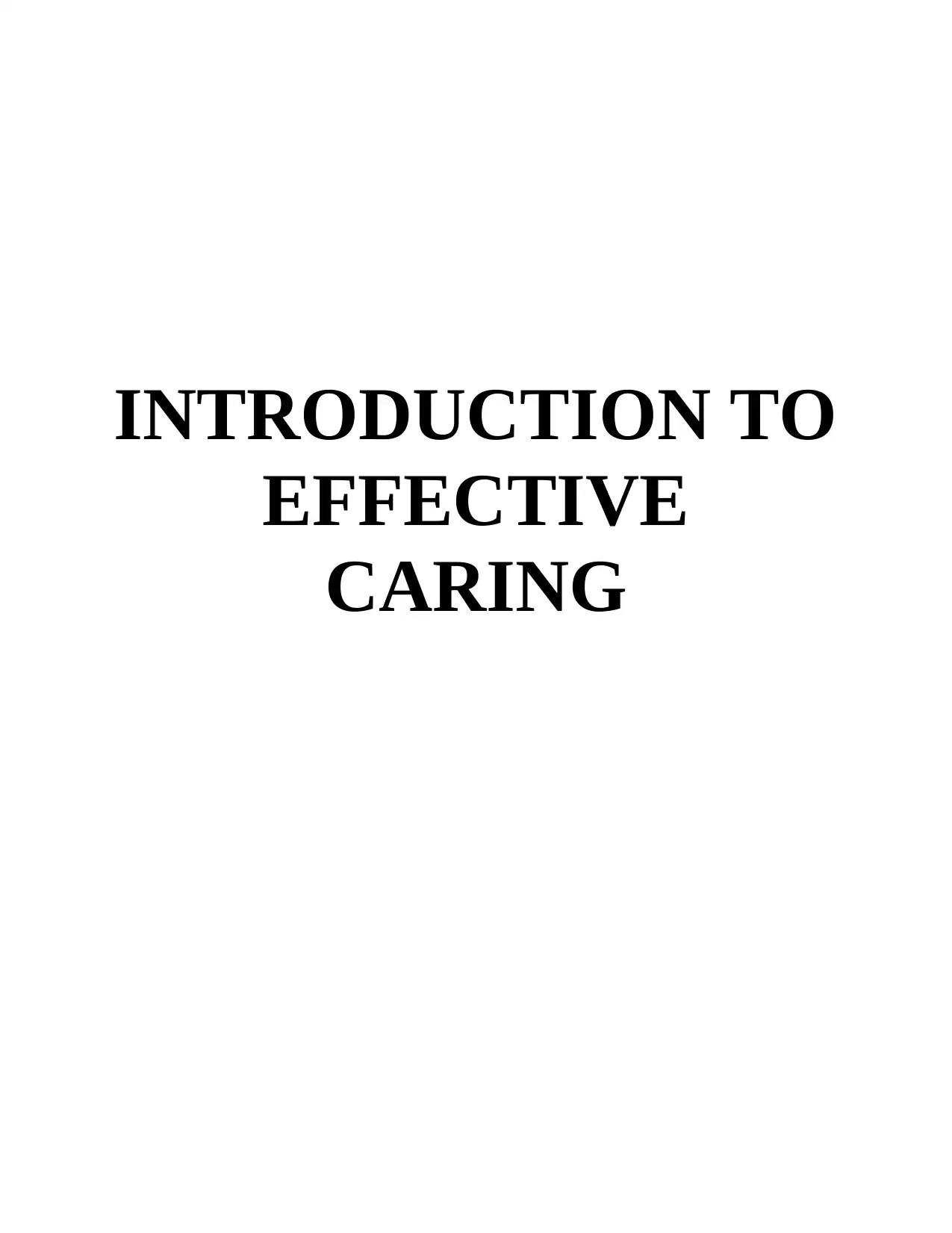
INTRODUCTION TO
EFFECTIVE
CARING
EFFECTIVE
CARING
Paraphrase This Document
Need a fresh take? Get an instant paraphrase of this document with our AI Paraphraser
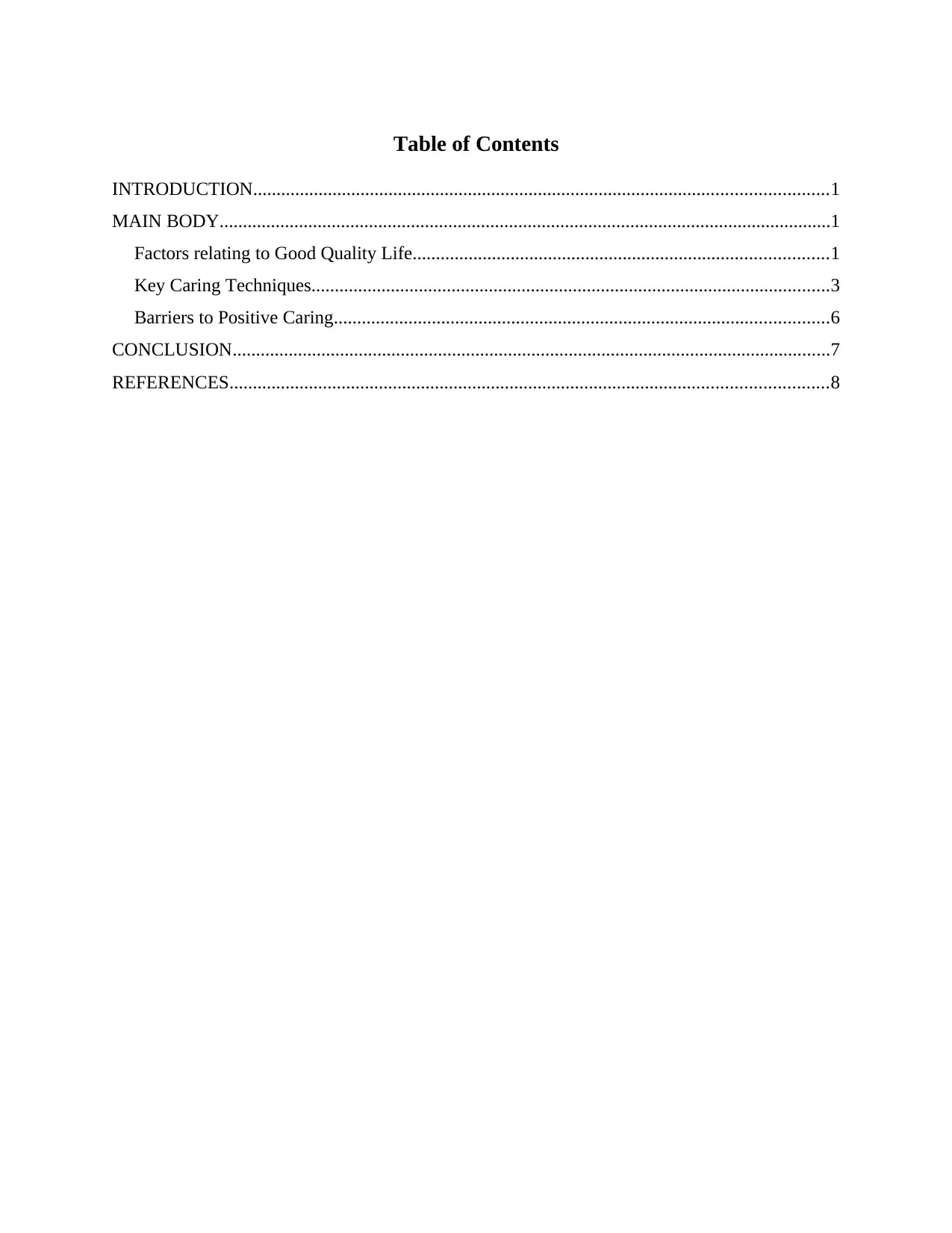
Table of Contents
INTRODUCTION...........................................................................................................................1
MAIN BODY...................................................................................................................................1
Factors relating to Good Quality Life.........................................................................................1
Key Caring Techniques...............................................................................................................3
Barriers to Positive Caring..........................................................................................................6
CONCLUSION................................................................................................................................7
REFERENCES................................................................................................................................8
INTRODUCTION...........................................................................................................................1
MAIN BODY...................................................................................................................................1
Factors relating to Good Quality Life.........................................................................................1
Key Caring Techniques...............................................................................................................3
Barriers to Positive Caring..........................................................................................................6
CONCLUSION................................................................................................................................7
REFERENCES................................................................................................................................8
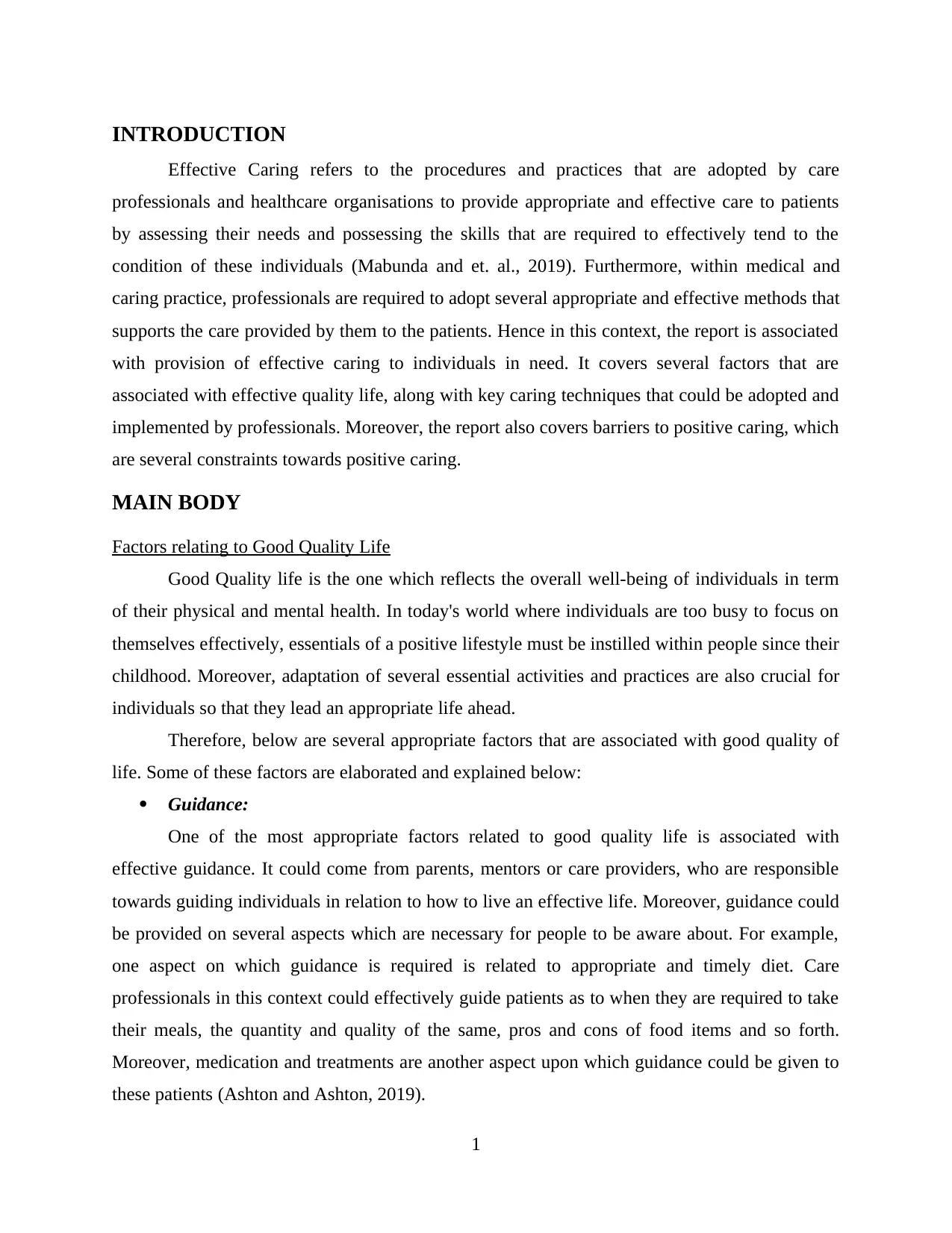
INTRODUCTION
Effective Caring refers to the procedures and practices that are adopted by care
professionals and healthcare organisations to provide appropriate and effective care to patients
by assessing their needs and possessing the skills that are required to effectively tend to the
condition of these individuals (Mabunda and et. al., 2019). Furthermore, within medical and
caring practice, professionals are required to adopt several appropriate and effective methods that
supports the care provided by them to the patients. Hence in this context, the report is associated
with provision of effective caring to individuals in need. It covers several factors that are
associated with effective quality life, along with key caring techniques that could be adopted and
implemented by professionals. Moreover, the report also covers barriers to positive caring, which
are several constraints towards positive caring.
MAIN BODY
Factors relating to Good Quality Life
Good Quality life is the one which reflects the overall well-being of individuals in term
of their physical and mental health. In today's world where individuals are too busy to focus on
themselves effectively, essentials of a positive lifestyle must be instilled within people since their
childhood. Moreover, adaptation of several essential activities and practices are also crucial for
individuals so that they lead an appropriate life ahead.
Therefore, below are several appropriate factors that are associated with good quality of
life. Some of these factors are elaborated and explained below:
Guidance:
One of the most appropriate factors related to good quality life is associated with
effective guidance. It could come from parents, mentors or care providers, who are responsible
towards guiding individuals in relation to how to live an effective life. Moreover, guidance could
be provided on several aspects which are necessary for people to be aware about. For example,
one aspect on which guidance is required is related to appropriate and timely diet. Care
professionals in this context could effectively guide patients as to when they are required to take
their meals, the quantity and quality of the same, pros and cons of food items and so forth.
Moreover, medication and treatments are another aspect upon which guidance could be given to
these patients (Ashton and Ashton, 2019).
1
Effective Caring refers to the procedures and practices that are adopted by care
professionals and healthcare organisations to provide appropriate and effective care to patients
by assessing their needs and possessing the skills that are required to effectively tend to the
condition of these individuals (Mabunda and et. al., 2019). Furthermore, within medical and
caring practice, professionals are required to adopt several appropriate and effective methods that
supports the care provided by them to the patients. Hence in this context, the report is associated
with provision of effective caring to individuals in need. It covers several factors that are
associated with effective quality life, along with key caring techniques that could be adopted and
implemented by professionals. Moreover, the report also covers barriers to positive caring, which
are several constraints towards positive caring.
MAIN BODY
Factors relating to Good Quality Life
Good Quality life is the one which reflects the overall well-being of individuals in term
of their physical and mental health. In today's world where individuals are too busy to focus on
themselves effectively, essentials of a positive lifestyle must be instilled within people since their
childhood. Moreover, adaptation of several essential activities and practices are also crucial for
individuals so that they lead an appropriate life ahead.
Therefore, below are several appropriate factors that are associated with good quality of
life. Some of these factors are elaborated and explained below:
Guidance:
One of the most appropriate factors related to good quality life is associated with
effective guidance. It could come from parents, mentors or care providers, who are responsible
towards guiding individuals in relation to how to live an effective life. Moreover, guidance could
be provided on several aspects which are necessary for people to be aware about. For example,
one aspect on which guidance is required is related to appropriate and timely diet. Care
professionals in this context could effectively guide patients as to when they are required to take
their meals, the quantity and quality of the same, pros and cons of food items and so forth.
Moreover, medication and treatments are another aspect upon which guidance could be given to
these patients (Ashton and Ashton, 2019).
1
⊘ This is a preview!⊘
Do you want full access?
Subscribe today to unlock all pages.

Trusted by 1+ million students worldwide
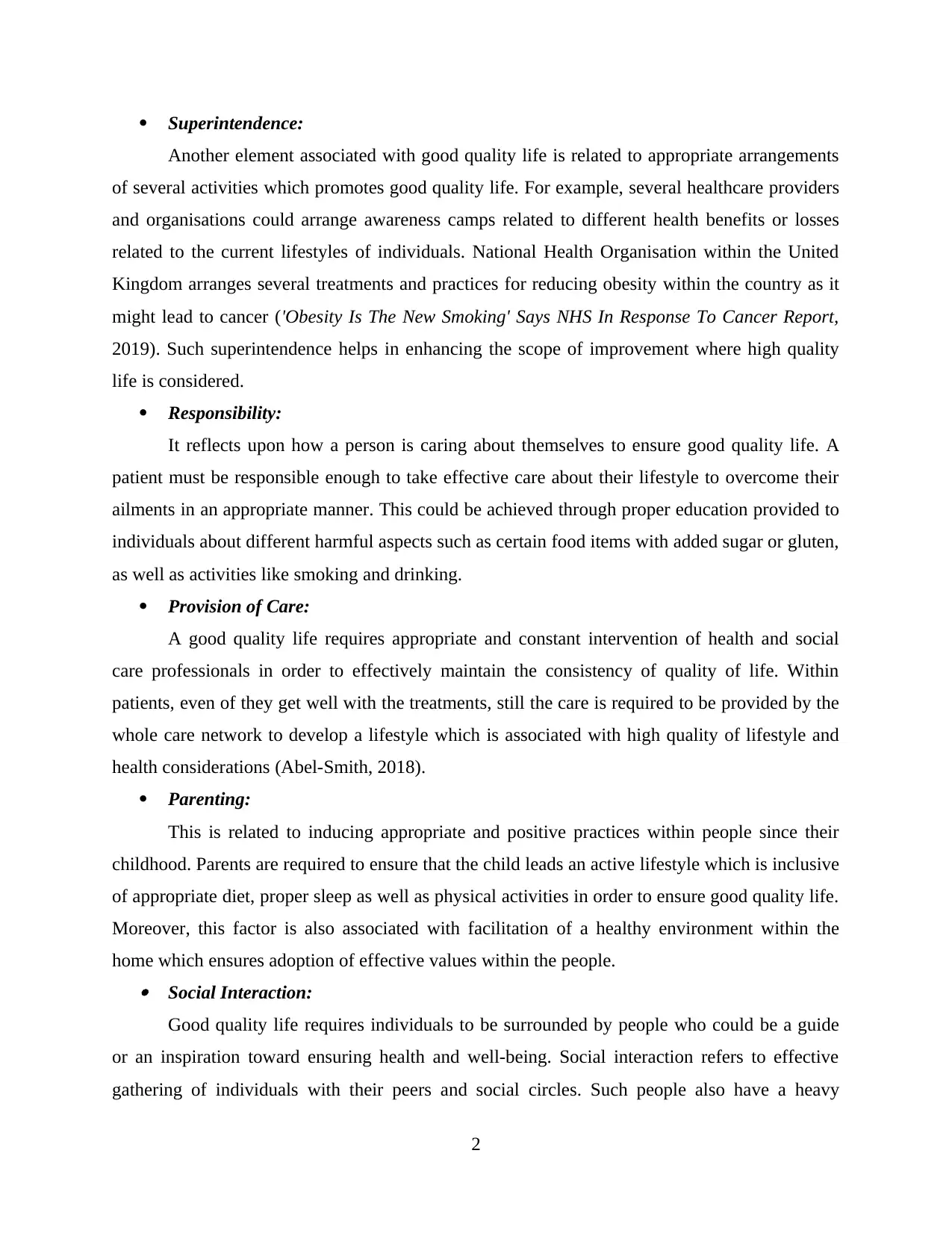
Superintendence:
Another element associated with good quality life is related to appropriate arrangements
of several activities which promotes good quality life. For example, several healthcare providers
and organisations could arrange awareness camps related to different health benefits or losses
related to the current lifestyles of individuals. National Health Organisation within the United
Kingdom arranges several treatments and practices for reducing obesity within the country as it
might lead to cancer ('Obesity Is The New Smoking' Says NHS In Response To Cancer Report,
2019). Such superintendence helps in enhancing the scope of improvement where high quality
life is considered.
Responsibility:
It reflects upon how a person is caring about themselves to ensure good quality life. A
patient must be responsible enough to take effective care about their lifestyle to overcome their
ailments in an appropriate manner. This could be achieved through proper education provided to
individuals about different harmful aspects such as certain food items with added sugar or gluten,
as well as activities like smoking and drinking.
Provision of Care:
A good quality life requires appropriate and constant intervention of health and social
care professionals in order to effectively maintain the consistency of quality of life. Within
patients, even of they get well with the treatments, still the care is required to be provided by the
whole care network to develop a lifestyle which is associated with high quality of lifestyle and
health considerations (Abel-Smith, 2018).
Parenting:
This is related to inducing appropriate and positive practices within people since their
childhood. Parents are required to ensure that the child leads an active lifestyle which is inclusive
of appropriate diet, proper sleep as well as physical activities in order to ensure good quality life.
Moreover, this factor is also associated with facilitation of a healthy environment within the
home which ensures adoption of effective values within the people. Social Interaction:
Good quality life requires individuals to be surrounded by people who could be a guide
or an inspiration toward ensuring health and well-being. Social interaction refers to effective
gathering of individuals with their peers and social circles. Such people also have a heavy
2
Another element associated with good quality life is related to appropriate arrangements
of several activities which promotes good quality life. For example, several healthcare providers
and organisations could arrange awareness camps related to different health benefits or losses
related to the current lifestyles of individuals. National Health Organisation within the United
Kingdom arranges several treatments and practices for reducing obesity within the country as it
might lead to cancer ('Obesity Is The New Smoking' Says NHS In Response To Cancer Report,
2019). Such superintendence helps in enhancing the scope of improvement where high quality
life is considered.
Responsibility:
It reflects upon how a person is caring about themselves to ensure good quality life. A
patient must be responsible enough to take effective care about their lifestyle to overcome their
ailments in an appropriate manner. This could be achieved through proper education provided to
individuals about different harmful aspects such as certain food items with added sugar or gluten,
as well as activities like smoking and drinking.
Provision of Care:
A good quality life requires appropriate and constant intervention of health and social
care professionals in order to effectively maintain the consistency of quality of life. Within
patients, even of they get well with the treatments, still the care is required to be provided by the
whole care network to develop a lifestyle which is associated with high quality of lifestyle and
health considerations (Abel-Smith, 2018).
Parenting:
This is related to inducing appropriate and positive practices within people since their
childhood. Parents are required to ensure that the child leads an active lifestyle which is inclusive
of appropriate diet, proper sleep as well as physical activities in order to ensure good quality life.
Moreover, this factor is also associated with facilitation of a healthy environment within the
home which ensures adoption of effective values within the people. Social Interaction:
Good quality life requires individuals to be surrounded by people who could be a guide
or an inspiration toward ensuring health and well-being. Social interaction refers to effective
gathering of individuals with their peers and social circles. Such people also have a heavy
2
Paraphrase This Document
Need a fresh take? Get an instant paraphrase of this document with our AI Paraphraser
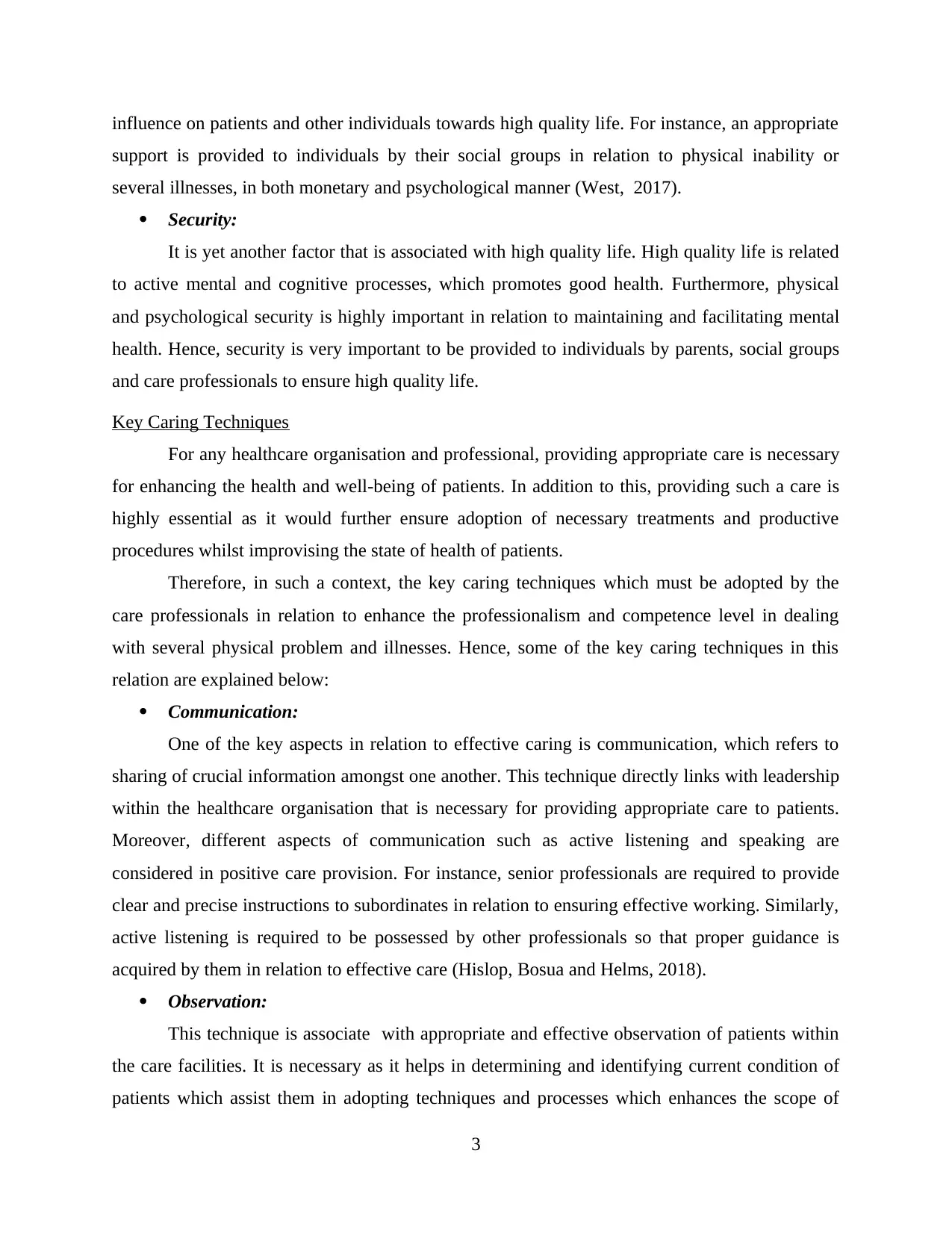
influence on patients and other individuals towards high quality life. For instance, an appropriate
support is provided to individuals by their social groups in relation to physical inability or
several illnesses, in both monetary and psychological manner (West, 2017).
Security:
It is yet another factor that is associated with high quality life. High quality life is related
to active mental and cognitive processes, which promotes good health. Furthermore, physical
and psychological security is highly important in relation to maintaining and facilitating mental
health. Hence, security is very important to be provided to individuals by parents, social groups
and care professionals to ensure high quality life.
Key Caring Techniques
For any healthcare organisation and professional, providing appropriate care is necessary
for enhancing the health and well-being of patients. In addition to this, providing such a care is
highly essential as it would further ensure adoption of necessary treatments and productive
procedures whilst improvising the state of health of patients.
Therefore, in such a context, the key caring techniques which must be adopted by the
care professionals in relation to enhance the professionalism and competence level in dealing
with several physical problem and illnesses. Hence, some of the key caring techniques in this
relation are explained below:
Communication:
One of the key aspects in relation to effective caring is communication, which refers to
sharing of crucial information amongst one another. This technique directly links with leadership
within the healthcare organisation that is necessary for providing appropriate care to patients.
Moreover, different aspects of communication such as active listening and speaking are
considered in positive care provision. For instance, senior professionals are required to provide
clear and precise instructions to subordinates in relation to ensuring effective working. Similarly,
active listening is required to be possessed by other professionals so that proper guidance is
acquired by them in relation to effective care (Hislop, Bosua and Helms, 2018).
Observation:
This technique is associate with appropriate and effective observation of patients within
the care facilities. It is necessary as it helps in determining and identifying current condition of
patients which assist them in adopting techniques and processes which enhances the scope of
3
support is provided to individuals by their social groups in relation to physical inability or
several illnesses, in both monetary and psychological manner (West, 2017).
Security:
It is yet another factor that is associated with high quality life. High quality life is related
to active mental and cognitive processes, which promotes good health. Furthermore, physical
and psychological security is highly important in relation to maintaining and facilitating mental
health. Hence, security is very important to be provided to individuals by parents, social groups
and care professionals to ensure high quality life.
Key Caring Techniques
For any healthcare organisation and professional, providing appropriate care is necessary
for enhancing the health and well-being of patients. In addition to this, providing such a care is
highly essential as it would further ensure adoption of necessary treatments and productive
procedures whilst improvising the state of health of patients.
Therefore, in such a context, the key caring techniques which must be adopted by the
care professionals in relation to enhance the professionalism and competence level in dealing
with several physical problem and illnesses. Hence, some of the key caring techniques in this
relation are explained below:
Communication:
One of the key aspects in relation to effective caring is communication, which refers to
sharing of crucial information amongst one another. This technique directly links with leadership
within the healthcare organisation that is necessary for providing appropriate care to patients.
Moreover, different aspects of communication such as active listening and speaking are
considered in positive care provision. For instance, senior professionals are required to provide
clear and precise instructions to subordinates in relation to ensuring effective working. Similarly,
active listening is required to be possessed by other professionals so that proper guidance is
acquired by them in relation to effective care (Hislop, Bosua and Helms, 2018).
Observation:
This technique is associate with appropriate and effective observation of patients within
the care facilities. It is necessary as it helps in determining and identifying current condition of
patients which assist them in adopting techniques and processes which enhances the scope of
3
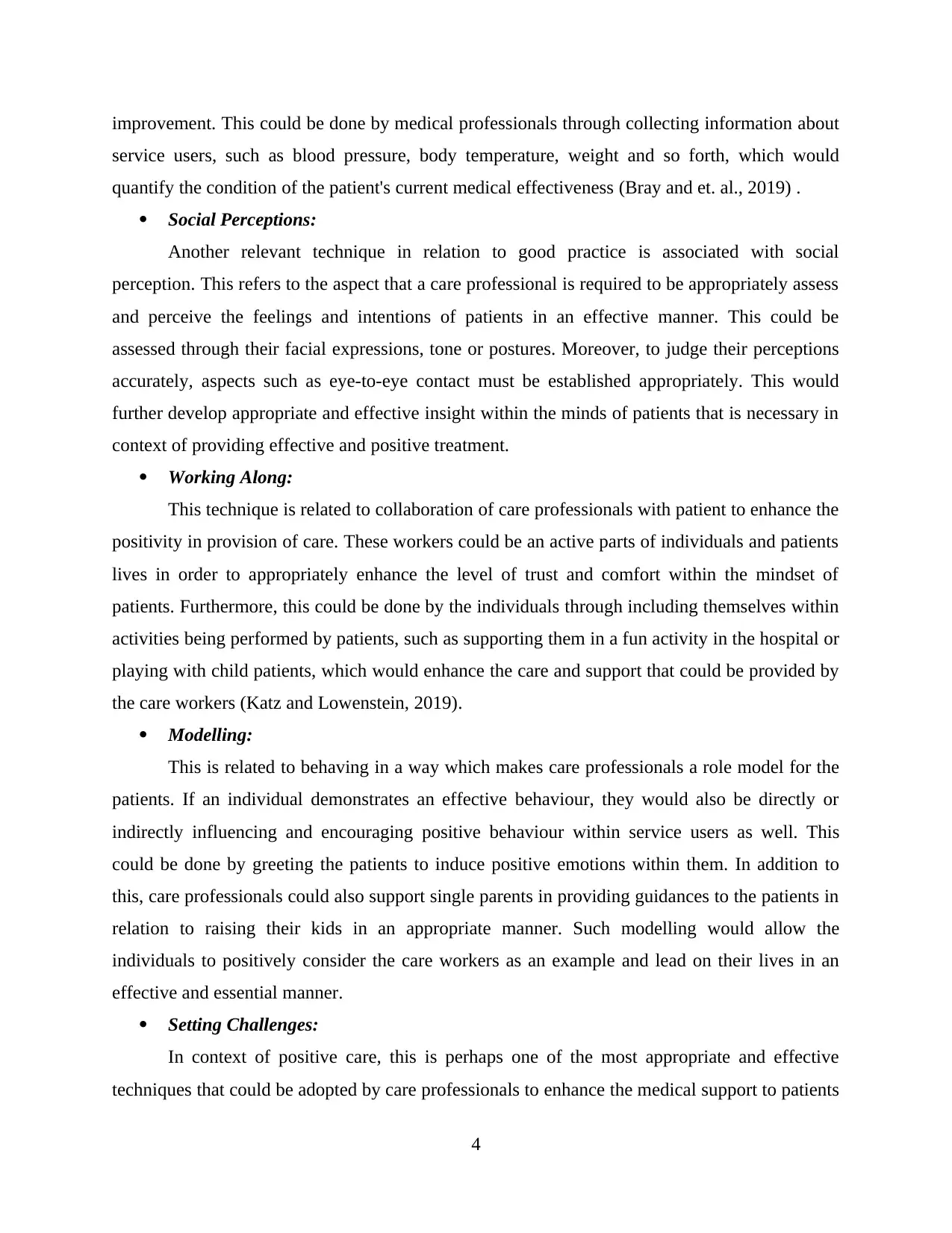
improvement. This could be done by medical professionals through collecting information about
service users, such as blood pressure, body temperature, weight and so forth, which would
quantify the condition of the patient's current medical effectiveness (Bray and et. al., 2019) .
Social Perceptions:
Another relevant technique in relation to good practice is associated with social
perception. This refers to the aspect that a care professional is required to be appropriately assess
and perceive the feelings and intentions of patients in an effective manner. This could be
assessed through their facial expressions, tone or postures. Moreover, to judge their perceptions
accurately, aspects such as eye-to-eye contact must be established appropriately. This would
further develop appropriate and effective insight within the minds of patients that is necessary in
context of providing effective and positive treatment.
Working Along:
This technique is related to collaboration of care professionals with patient to enhance the
positivity in provision of care. These workers could be an active parts of individuals and patients
lives in order to appropriately enhance the level of trust and comfort within the mindset of
patients. Furthermore, this could be done by the individuals through including themselves within
activities being performed by patients, such as supporting them in a fun activity in the hospital or
playing with child patients, which would enhance the care and support that could be provided by
the care workers (Katz and Lowenstein, 2019).
Modelling:
This is related to behaving in a way which makes care professionals a role model for the
patients. If an individual demonstrates an effective behaviour, they would also be directly or
indirectly influencing and encouraging positive behaviour within service users as well. This
could be done by greeting the patients to induce positive emotions within them. In addition to
this, care professionals could also support single parents in providing guidances to the patients in
relation to raising their kids in an appropriate manner. Such modelling would allow the
individuals to positively consider the care workers as an example and lead on their lives in an
effective and essential manner.
Setting Challenges:
In context of positive care, this is perhaps one of the most appropriate and effective
techniques that could be adopted by care professionals to enhance the medical support to patients
4
service users, such as blood pressure, body temperature, weight and so forth, which would
quantify the condition of the patient's current medical effectiveness (Bray and et. al., 2019) .
Social Perceptions:
Another relevant technique in relation to good practice is associated with social
perception. This refers to the aspect that a care professional is required to be appropriately assess
and perceive the feelings and intentions of patients in an effective manner. This could be
assessed through their facial expressions, tone or postures. Moreover, to judge their perceptions
accurately, aspects such as eye-to-eye contact must be established appropriately. This would
further develop appropriate and effective insight within the minds of patients that is necessary in
context of providing effective and positive treatment.
Working Along:
This technique is related to collaboration of care professionals with patient to enhance the
positivity in provision of care. These workers could be an active parts of individuals and patients
lives in order to appropriately enhance the level of trust and comfort within the mindset of
patients. Furthermore, this could be done by the individuals through including themselves within
activities being performed by patients, such as supporting them in a fun activity in the hospital or
playing with child patients, which would enhance the care and support that could be provided by
the care workers (Katz and Lowenstein, 2019).
Modelling:
This is related to behaving in a way which makes care professionals a role model for the
patients. If an individual demonstrates an effective behaviour, they would also be directly or
indirectly influencing and encouraging positive behaviour within service users as well. This
could be done by greeting the patients to induce positive emotions within them. In addition to
this, care professionals could also support single parents in providing guidances to the patients in
relation to raising their kids in an appropriate manner. Such modelling would allow the
individuals to positively consider the care workers as an example and lead on their lives in an
effective and essential manner.
Setting Challenges:
In context of positive care, this is perhaps one of the most appropriate and effective
techniques that could be adopted by care professionals to enhance the medical support to patients
4
⊘ This is a preview!⊘
Do you want full access?
Subscribe today to unlock all pages.

Trusted by 1+ million students worldwide
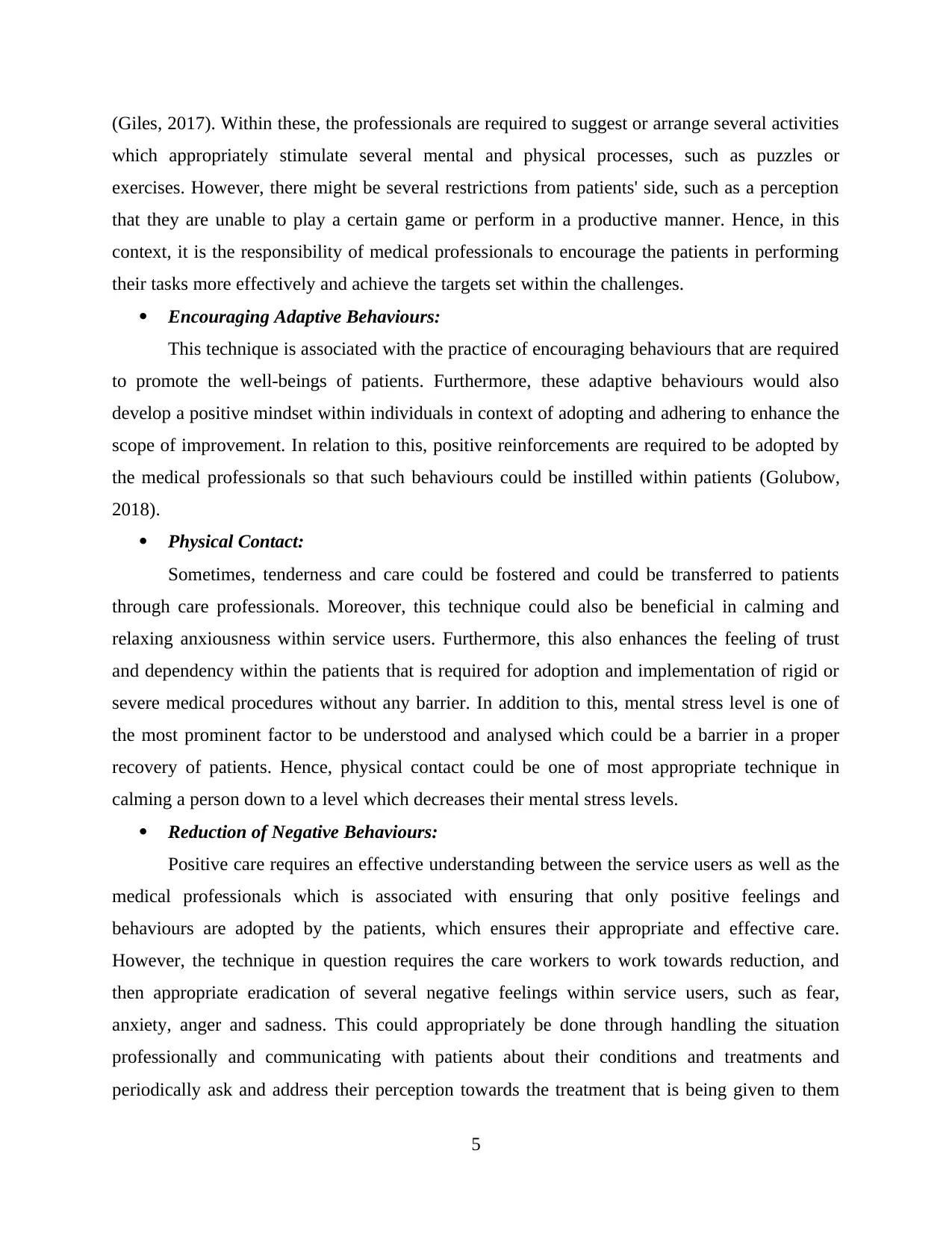
(Giles, 2017). Within these, the professionals are required to suggest or arrange several activities
which appropriately stimulate several mental and physical processes, such as puzzles or
exercises. However, there might be several restrictions from patients' side, such as a perception
that they are unable to play a certain game or perform in a productive manner. Hence, in this
context, it is the responsibility of medical professionals to encourage the patients in performing
their tasks more effectively and achieve the targets set within the challenges.
Encouraging Adaptive Behaviours:
This technique is associated with the practice of encouraging behaviours that are required
to promote the well-beings of patients. Furthermore, these adaptive behaviours would also
develop a positive mindset within individuals in context of adopting and adhering to enhance the
scope of improvement. In relation to this, positive reinforcements are required to be adopted by
the medical professionals so that such behaviours could be instilled within patients (Golubow,
2018).
Physical Contact:
Sometimes, tenderness and care could be fostered and could be transferred to patients
through care professionals. Moreover, this technique could also be beneficial in calming and
relaxing anxiousness within service users. Furthermore, this also enhances the feeling of trust
and dependency within the patients that is required for adoption and implementation of rigid or
severe medical procedures without any barrier. In addition to this, mental stress level is one of
the most prominent factor to be understood and analysed which could be a barrier in a proper
recovery of patients. Hence, physical contact could be one of most appropriate technique in
calming a person down to a level which decreases their mental stress levels.
Reduction of Negative Behaviours:
Positive care requires an effective understanding between the service users as well as the
medical professionals which is associated with ensuring that only positive feelings and
behaviours are adopted by the patients, which ensures their appropriate and effective care.
However, the technique in question requires the care workers to work towards reduction, and
then appropriate eradication of several negative feelings within service users, such as fear,
anxiety, anger and sadness. This could appropriately be done through handling the situation
professionally and communicating with patients about their conditions and treatments and
periodically ask and address their perception towards the treatment that is being given to them
5
which appropriately stimulate several mental and physical processes, such as puzzles or
exercises. However, there might be several restrictions from patients' side, such as a perception
that they are unable to play a certain game or perform in a productive manner. Hence, in this
context, it is the responsibility of medical professionals to encourage the patients in performing
their tasks more effectively and achieve the targets set within the challenges.
Encouraging Adaptive Behaviours:
This technique is associated with the practice of encouraging behaviours that are required
to promote the well-beings of patients. Furthermore, these adaptive behaviours would also
develop a positive mindset within individuals in context of adopting and adhering to enhance the
scope of improvement. In relation to this, positive reinforcements are required to be adopted by
the medical professionals so that such behaviours could be instilled within patients (Golubow,
2018).
Physical Contact:
Sometimes, tenderness and care could be fostered and could be transferred to patients
through care professionals. Moreover, this technique could also be beneficial in calming and
relaxing anxiousness within service users. Furthermore, this also enhances the feeling of trust
and dependency within the patients that is required for adoption and implementation of rigid or
severe medical procedures without any barrier. In addition to this, mental stress level is one of
the most prominent factor to be understood and analysed which could be a barrier in a proper
recovery of patients. Hence, physical contact could be one of most appropriate technique in
calming a person down to a level which decreases their mental stress levels.
Reduction of Negative Behaviours:
Positive care requires an effective understanding between the service users as well as the
medical professionals which is associated with ensuring that only positive feelings and
behaviours are adopted by the patients, which ensures their appropriate and effective care.
However, the technique in question requires the care workers to work towards reduction, and
then appropriate eradication of several negative feelings within service users, such as fear,
anxiety, anger and sadness. This could appropriately be done through handling the situation
professionally and communicating with patients about their conditions and treatments and
periodically ask and address their perception towards the treatment that is being given to them
5
Paraphrase This Document
Need a fresh take? Get an instant paraphrase of this document with our AI Paraphraser
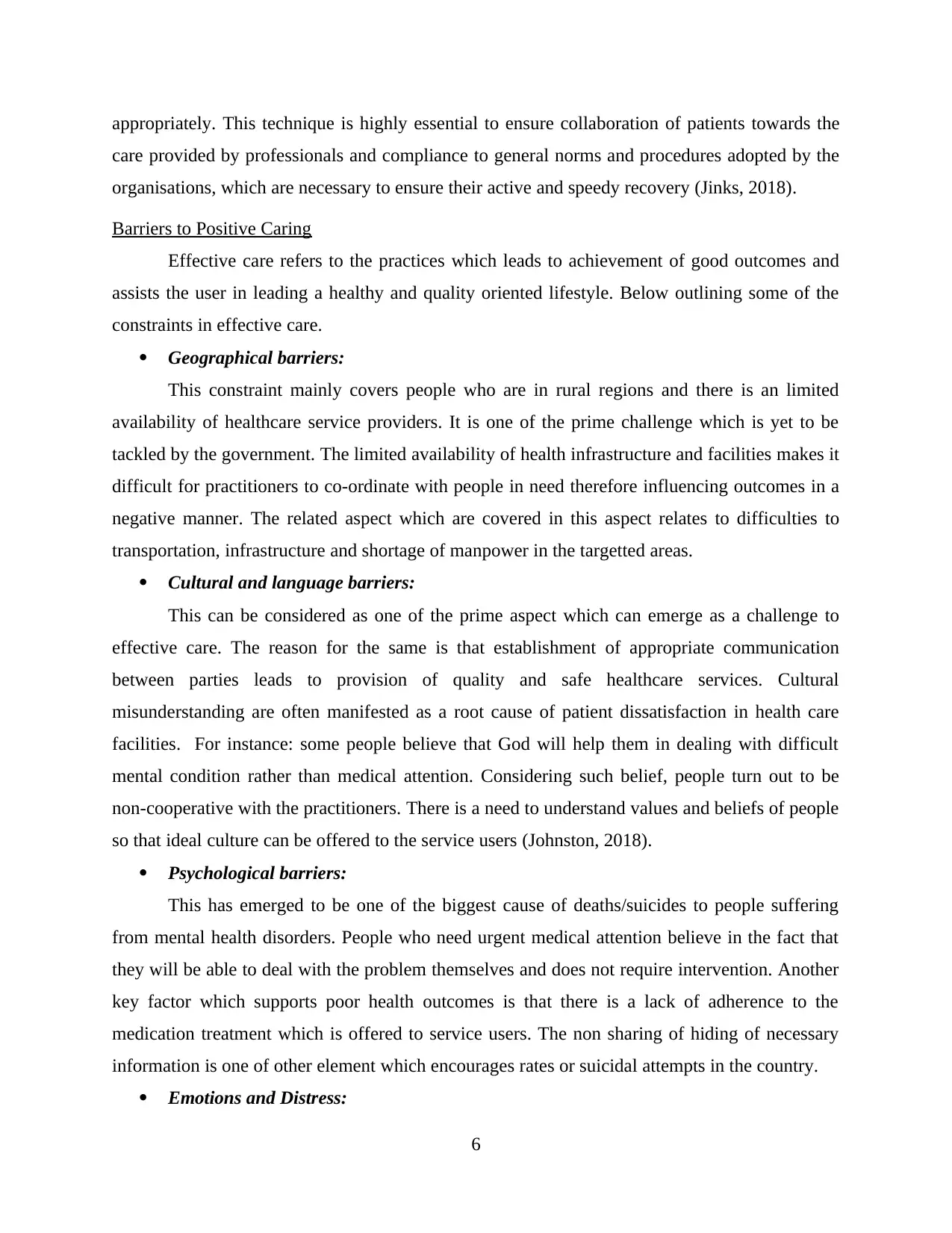
appropriately. This technique is highly essential to ensure collaboration of patients towards the
care provided by professionals and compliance to general norms and procedures adopted by the
organisations, which are necessary to ensure their active and speedy recovery (Jinks, 2018).
Barriers to Positive Caring
Effective care refers to the practices which leads to achievement of good outcomes and
assists the user in leading a healthy and quality oriented lifestyle. Below outlining some of the
constraints in effective care.
Geographical barriers:
This constraint mainly covers people who are in rural regions and there is an limited
availability of healthcare service providers. It is one of the prime challenge which is yet to be
tackled by the government. The limited availability of health infrastructure and facilities makes it
difficult for practitioners to co-ordinate with people in need therefore influencing outcomes in a
negative manner. The related aspect which are covered in this aspect relates to difficulties to
transportation, infrastructure and shortage of manpower in the targetted areas.
Cultural and language barriers:
This can be considered as one of the prime aspect which can emerge as a challenge to
effective care. The reason for the same is that establishment of appropriate communication
between parties leads to provision of quality and safe healthcare services. Cultural
misunderstanding are often manifested as a root cause of patient dissatisfaction in health care
facilities. For instance: some people believe that God will help them in dealing with difficult
mental condition rather than medical attention. Considering such belief, people turn out to be
non-cooperative with the practitioners. There is a need to understand values and beliefs of people
so that ideal culture can be offered to the service users (Johnston, 2018).
Psychological barriers:
This has emerged to be one of the biggest cause of deaths/suicides to people suffering
from mental health disorders. People who need urgent medical attention believe in the fact that
they will be able to deal with the problem themselves and does not require intervention. Another
key factor which supports poor health outcomes is that there is a lack of adherence to the
medication treatment which is offered to service users. The non sharing of hiding of necessary
information is one of other element which encourages rates or suicidal attempts in the country.
Emotions and Distress:
6
care provided by professionals and compliance to general norms and procedures adopted by the
organisations, which are necessary to ensure their active and speedy recovery (Jinks, 2018).
Barriers to Positive Caring
Effective care refers to the practices which leads to achievement of good outcomes and
assists the user in leading a healthy and quality oriented lifestyle. Below outlining some of the
constraints in effective care.
Geographical barriers:
This constraint mainly covers people who are in rural regions and there is an limited
availability of healthcare service providers. It is one of the prime challenge which is yet to be
tackled by the government. The limited availability of health infrastructure and facilities makes it
difficult for practitioners to co-ordinate with people in need therefore influencing outcomes in a
negative manner. The related aspect which are covered in this aspect relates to difficulties to
transportation, infrastructure and shortage of manpower in the targetted areas.
Cultural and language barriers:
This can be considered as one of the prime aspect which can emerge as a challenge to
effective care. The reason for the same is that establishment of appropriate communication
between parties leads to provision of quality and safe healthcare services. Cultural
misunderstanding are often manifested as a root cause of patient dissatisfaction in health care
facilities. For instance: some people believe that God will help them in dealing with difficult
mental condition rather than medical attention. Considering such belief, people turn out to be
non-cooperative with the practitioners. There is a need to understand values and beliefs of people
so that ideal culture can be offered to the service users (Johnston, 2018).
Psychological barriers:
This has emerged to be one of the biggest cause of deaths/suicides to people suffering
from mental health disorders. People who need urgent medical attention believe in the fact that
they will be able to deal with the problem themselves and does not require intervention. Another
key factor which supports poor health outcomes is that there is a lack of adherence to the
medication treatment which is offered to service users. The non sharing of hiding of necessary
information is one of other element which encourages rates or suicidal attempts in the country.
Emotions and Distress:
6
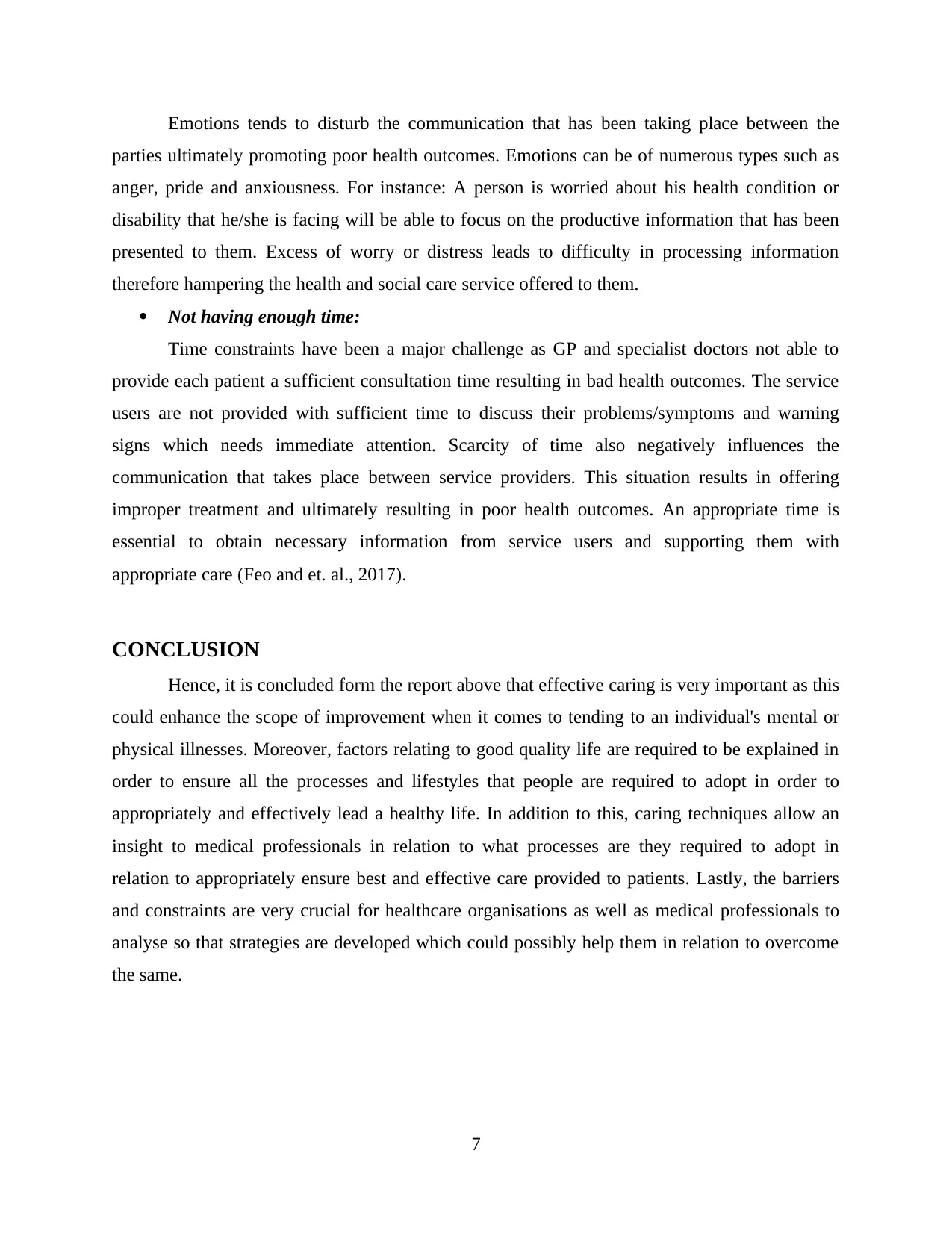
Emotions tends to disturb the communication that has been taking place between the
parties ultimately promoting poor health outcomes. Emotions can be of numerous types such as
anger, pride and anxiousness. For instance: A person is worried about his health condition or
disability that he/she is facing will be able to focus on the productive information that has been
presented to them. Excess of worry or distress leads to difficulty in processing information
therefore hampering the health and social care service offered to them.
Not having enough time:
Time constraints have been a major challenge as GP and specialist doctors not able to
provide each patient a sufficient consultation time resulting in bad health outcomes. The service
users are not provided with sufficient time to discuss their problems/symptoms and warning
signs which needs immediate attention. Scarcity of time also negatively influences the
communication that takes place between service providers. This situation results in offering
improper treatment and ultimately resulting in poor health outcomes. An appropriate time is
essential to obtain necessary information from service users and supporting them with
appropriate care (Feo and et. al., 2017).
CONCLUSION
Hence, it is concluded form the report above that effective caring is very important as this
could enhance the scope of improvement when it comes to tending to an individual's mental or
physical illnesses. Moreover, factors relating to good quality life are required to be explained in
order to ensure all the processes and lifestyles that people are required to adopt in order to
appropriately and effectively lead a healthy life. In addition to this, caring techniques allow an
insight to medical professionals in relation to what processes are they required to adopt in
relation to appropriately ensure best and effective care provided to patients. Lastly, the barriers
and constraints are very crucial for healthcare organisations as well as medical professionals to
analyse so that strategies are developed which could possibly help them in relation to overcome
the same.
7
parties ultimately promoting poor health outcomes. Emotions can be of numerous types such as
anger, pride and anxiousness. For instance: A person is worried about his health condition or
disability that he/she is facing will be able to focus on the productive information that has been
presented to them. Excess of worry or distress leads to difficulty in processing information
therefore hampering the health and social care service offered to them.
Not having enough time:
Time constraints have been a major challenge as GP and specialist doctors not able to
provide each patient a sufficient consultation time resulting in bad health outcomes. The service
users are not provided with sufficient time to discuss their problems/symptoms and warning
signs which needs immediate attention. Scarcity of time also negatively influences the
communication that takes place between service providers. This situation results in offering
improper treatment and ultimately resulting in poor health outcomes. An appropriate time is
essential to obtain necessary information from service users and supporting them with
appropriate care (Feo and et. al., 2017).
CONCLUSION
Hence, it is concluded form the report above that effective caring is very important as this
could enhance the scope of improvement when it comes to tending to an individual's mental or
physical illnesses. Moreover, factors relating to good quality life are required to be explained in
order to ensure all the processes and lifestyles that people are required to adopt in order to
appropriately and effectively lead a healthy life. In addition to this, caring techniques allow an
insight to medical professionals in relation to what processes are they required to adopt in
relation to appropriately ensure best and effective care provided to patients. Lastly, the barriers
and constraints are very crucial for healthcare organisations as well as medical professionals to
analyse so that strategies are developed which could possibly help them in relation to overcome
the same.
7
⊘ This is a preview!⊘
Do you want full access?
Subscribe today to unlock all pages.

Trusted by 1+ million students worldwide
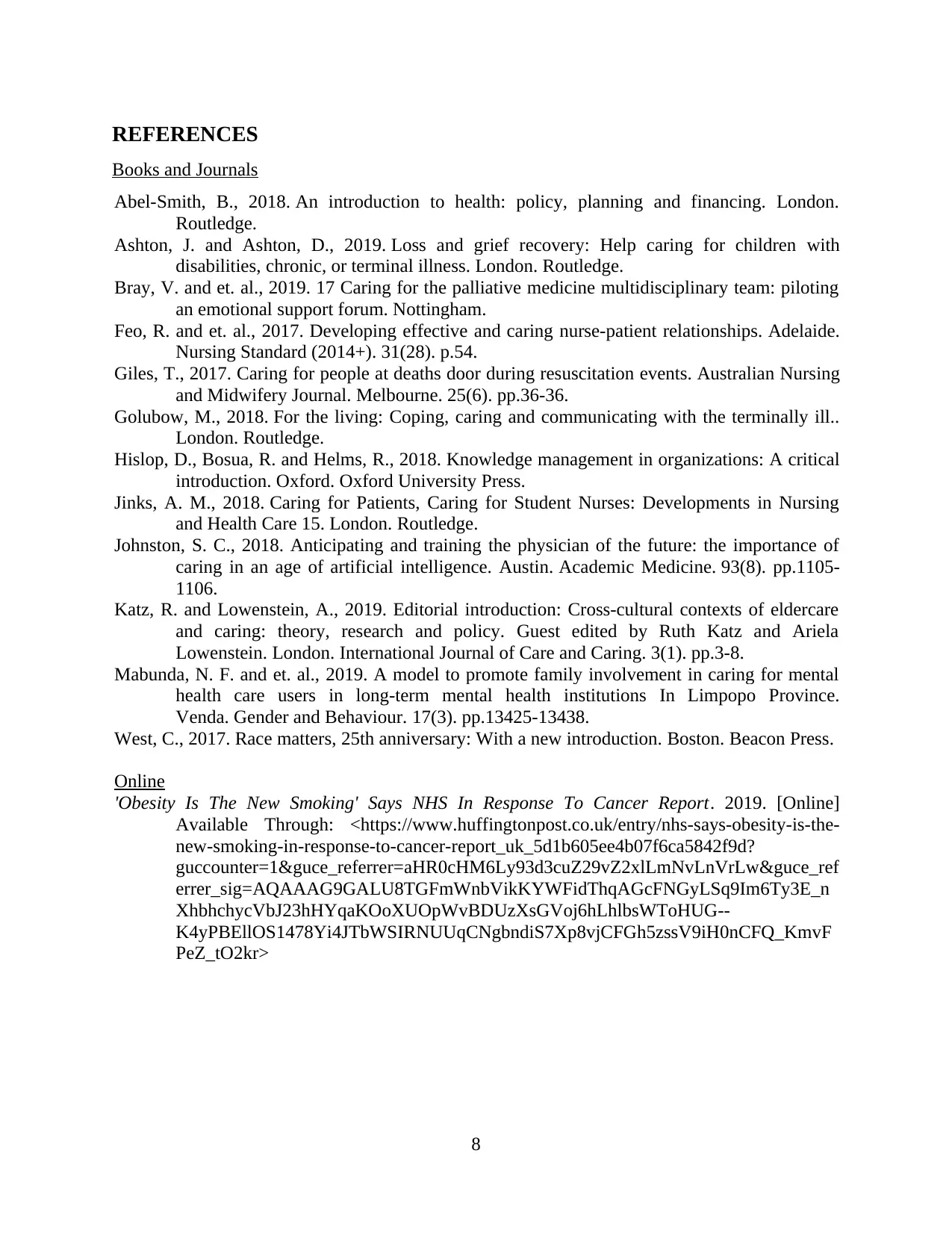
REFERENCES
Books and Journals
Abel-Smith, B., 2018. An introduction to health: policy, planning and financing. London.
Routledge.
Ashton, J. and Ashton, D., 2019. Loss and grief recovery: Help caring for children with
disabilities, chronic, or terminal illness. London. Routledge.
Bray, V. and et. al., 2019. 17 Caring for the palliative medicine multidisciplinary team: piloting
an emotional support forum. Nottingham.
Feo, R. and et. al., 2017. Developing effective and caring nurse-patient relationships. Adelaide.
Nursing Standard (2014+). 31(28). p.54.
Giles, T., 2017. Caring for people at deaths door during resuscitation events. Australian Nursing
and Midwifery Journal. Melbourne. 25(6). pp.36-36.
Golubow, M., 2018. For the living: Coping, caring and communicating with the terminally ill..
London. Routledge.
Hislop, D., Bosua, R. and Helms, R., 2018. Knowledge management in organizations: A critical
introduction. Oxford. Oxford University Press.
Jinks, A. M., 2018. Caring for Patients, Caring for Student Nurses: Developments in Nursing
and Health Care 15. London. Routledge.
Johnston, S. C., 2018. Anticipating and training the physician of the future: the importance of
caring in an age of artificial intelligence. Austin. Academic Medicine. 93(8). pp.1105-
1106.
Katz, R. and Lowenstein, A., 2019. Editorial introduction: Cross-cultural contexts of eldercare
and caring: theory, research and policy. Guest edited by Ruth Katz and Ariela
Lowenstein. London. International Journal of Care and Caring. 3(1). pp.3-8.
Mabunda, N. F. and et. al., 2019. A model to promote family involvement in caring for mental
health care users in long-term mental health institutions In Limpopo Province.
Venda. Gender and Behaviour. 17(3). pp.13425-13438.
West, C., 2017. Race matters, 25th anniversary: With a new introduction. Boston. Beacon Press.
Online
'Obesity Is The New Smoking' Says NHS In Response To Cancer Report. 2019. [Online]
Available Through: <https://www.huffingtonpost.co.uk/entry/nhs-says-obesity-is-the-
new-smoking-in-response-to-cancer-report_uk_5d1b605ee4b07f6ca5842f9d?
guccounter=1&guce_referrer=aHR0cHM6Ly93d3cuZ29vZ2xlLmNvLnVrLw&guce_ref
errer_sig=AQAAAG9GALU8TGFmWnbVikKYWFidThqAGcFNGyLSq9Im6Ty3E_n
XhbhchycVbJ23hHYqaKOoXUOpWvBDUzXsGVoj6hLhlbsWToHUG--
K4yPBEllOS1478Yi4JTbWSIRNUUqCNgbndiS7Xp8vjCFGh5zssV9iH0nCFQ_KmvF
PeZ_tO2kr>
8
Books and Journals
Abel-Smith, B., 2018. An introduction to health: policy, planning and financing. London.
Routledge.
Ashton, J. and Ashton, D., 2019. Loss and grief recovery: Help caring for children with
disabilities, chronic, or terminal illness. London. Routledge.
Bray, V. and et. al., 2019. 17 Caring for the palliative medicine multidisciplinary team: piloting
an emotional support forum. Nottingham.
Feo, R. and et. al., 2017. Developing effective and caring nurse-patient relationships. Adelaide.
Nursing Standard (2014+). 31(28). p.54.
Giles, T., 2017. Caring for people at deaths door during resuscitation events. Australian Nursing
and Midwifery Journal. Melbourne. 25(6). pp.36-36.
Golubow, M., 2018. For the living: Coping, caring and communicating with the terminally ill..
London. Routledge.
Hislop, D., Bosua, R. and Helms, R., 2018. Knowledge management in organizations: A critical
introduction. Oxford. Oxford University Press.
Jinks, A. M., 2018. Caring for Patients, Caring for Student Nurses: Developments in Nursing
and Health Care 15. London. Routledge.
Johnston, S. C., 2018. Anticipating and training the physician of the future: the importance of
caring in an age of artificial intelligence. Austin. Academic Medicine. 93(8). pp.1105-
1106.
Katz, R. and Lowenstein, A., 2019. Editorial introduction: Cross-cultural contexts of eldercare
and caring: theory, research and policy. Guest edited by Ruth Katz and Ariela
Lowenstein. London. International Journal of Care and Caring. 3(1). pp.3-8.
Mabunda, N. F. and et. al., 2019. A model to promote family involvement in caring for mental
health care users in long-term mental health institutions In Limpopo Province.
Venda. Gender and Behaviour. 17(3). pp.13425-13438.
West, C., 2017. Race matters, 25th anniversary: With a new introduction. Boston. Beacon Press.
Online
'Obesity Is The New Smoking' Says NHS In Response To Cancer Report. 2019. [Online]
Available Through: <https://www.huffingtonpost.co.uk/entry/nhs-says-obesity-is-the-
new-smoking-in-response-to-cancer-report_uk_5d1b605ee4b07f6ca5842f9d?
guccounter=1&guce_referrer=aHR0cHM6Ly93d3cuZ29vZ2xlLmNvLnVrLw&guce_ref
errer_sig=AQAAAG9GALU8TGFmWnbVikKYWFidThqAGcFNGyLSq9Im6Ty3E_n
XhbhchycVbJ23hHYqaKOoXUOpWvBDUzXsGVoj6hLhlbsWToHUG--
K4yPBEllOS1478Yi4JTbWSIRNUUqCNgbndiS7Xp8vjCFGh5zssV9iH0nCFQ_KmvF
PeZ_tO2kr>
8
1 out of 10
Related Documents
Your All-in-One AI-Powered Toolkit for Academic Success.
+13062052269
info@desklib.com
Available 24*7 on WhatsApp / Email
![[object Object]](/_next/static/media/star-bottom.7253800d.svg)
Unlock your academic potential
Copyright © 2020–2025 A2Z Services. All Rights Reserved. Developed and managed by ZUCOL.





